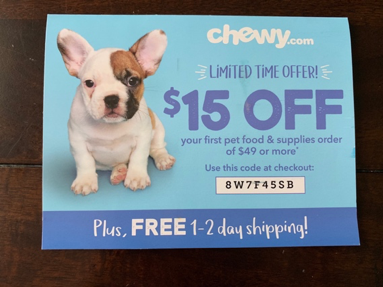My New Puppy Journey Revealed the Power of Omni-Channel Marketing
How two retailers hit all the right touch points at the right time.
The always brilliant Drew McLellan of the Agency Management Institute recently shared a great study on audience expectations with omni-channel marketing. From the CMO Council and Pitney Bowes, Critical Channels of Choice nets out with this important revelation: Omni-channel IS the critical channel of choice.
This 30+ page survey report is chock full of insight, but the revelations didn’t hit me full-circle until I experienced smart omni-channel marketing in action.
The start of my customer journey
We recently brought home a Golden Retriever puppy named Luna. In preparation for her arrival, I perused some go-to online retailers for all of the essentials. One of my favorites is Chewy.com.
Like many consumers, I shopped Chewy.com and also looked at Amazon.com for price comparable items. I didn’t immediately pull the trigger and buy anything.
Meanwhile, I did more research about the breed, proper puppy care, what to expect with training, etc. And that’s when Chewy.com seized their opportunity. They hit me with retargeting ads that contained items I’d been looking at, along with other puppy essentials.
Chewy.com figured out – based on my behavior on their website – that I’m a user who is interested in puppy-related items. They get me. They get my customer journey.
How do you get to know your customer’s journey?
Be curious. Work with your marketing and sales team to gather insight. This may involve a formal study or simple, informal surveys with existing customers. This type of work doesn’t always come with a Goliath price tag; however, it’s important to learn as much as you can within your budget.
The goal is to find out what channels your audience uses to make purchase decisions and when, like Chewy.com figured out with me. Get answers to the following questions:
- Where are they looking? Is it news articles or blog posts? Website product pages? Reviews? Newsletters? Social media? Point of Sale? Mail?
- When are they looking? When something breaks? When a new need arises? When a new idea is percolating?
In my interactions with Chewy.com, they got locked in on my customer journey through data capture. That’s not always kosher with some folks. More on that in second.
From data to direct mail
Chewy.com kept hitting me with retargeting ads. As a marketer, I could see exactly what they were up to. But, then I receive a direct mail from Chewy.com, and my mind was blown. I didn’t sign up for anything on their website, but their data capture was sophisticated enough to figure out who I am and where I live.

That leads me to a shocker insight contained in the report. One out of three consumers wants to receive information via Mail. That’s right, the most traditional approach is still part of the ideal communication mix.
I definitely took notice of the direct mail Chewy.com sent. It had a nice purchase incentive. Notice the adorable French Bulldog puppy they also used to reel me in. How could you say no to that face?
Important note: Data capture and privacy
Adorable puppies or not, many people are concerned about their privacy online. Chewy.com’s approach didn’t both me, but that’s not true for everyone. Out of curiosity, I looked at their privacy policy, and they’re transparent about what they’re doing and how you can opt out.
Online data capture is one way to help brands get to know their audiences. And 40% of consumers are okay with some data capture, but 21% don’t want data stored, even if it takes away from personalization.
A smart strategy is to explain WHY your brand is collecting data and HOW you plan to use it. Reinforce that you’ll protect their privacy. Then, you’ll give them content that’s personalized to their individual needs and wants. It’s important for brands to work hard to earn customer confidence.
Beyond digital: The in-store experience
Ultimately, I did buy some items from Chewy.com, but I also chose to go to a brick and mortar retailer for more pupperino purchases. As my kids I and navigated the aisles of our local Petco, we were overwhelmed by the countless options. In truth, I don’t have the time to spend three hours at a retailer trying to figure it out.
Neither do most other people. According to the report, 50% of consumers said that convenience was a critical attribute that keeps customers coming back. Reliability (45%) and speed (41%) were also important ways that the channel can respond to deliver value or address needs.
Then the store’s general manager stepped up on the scene and killed it in every area. He quickly learned we were getting a puppy, observed that I had two spazzed out kids in tow and helped me right away. He quickly provided point-of-sale materials and reviewed some options, and we were armed and ready in an hour. He even gave us a guide to your new puppy chock full incentives that ultimately saved me $150.
Will I go back? Hell yes! But, I’ll likely also buy from Chewy.com because they have a buttoned up digital approach and it’ll be easier to have items delivered right to my door at times.
Omni-channel isn’t every channel
The report revealed that an overwhelming 85% of consumers are like me – they agree that their ideal channel is actually a blend. So, one channel doesn’t win them all, and that’s true of different age demographics. The initial gut reaction is: If consumers want multiple channels, do I have to be everywhere, all the time? Absolutely not.
But, this is where things get tricky. Fifty-nine percent of consumers say they don’t need companies to be everywhere, BUT they should be there when I really need something. Twenty-eight percent say companies should be where I want, when I want as well as ready to share and communicate what to expect. It’s what I expected, and the retailers I interacted with delivered – online and in-store.
What does this mean? You must have a DEEP understanding of your customer journey across multiple segments. Don’t try to guess, otherwise you’ll serve up the right answers in the wrong places or to the wrong audience. Do your research and get hyper-targeted with your communications so they’re ready in the precise moment your customers need them.
About the Author
Julie Jones is the Vice President of Communications Strategy at Muse. With over 15 years of experience as an award-winning creative director and copywriter at leading advertising agencies, she has delivered powerful brand and content marketing strategies to a diverse portfolio of clients in the health care, manufacturing, technology and consumer products industries. Some of her most notable clients include University Hospitals, Legacy Health System, GE Lighting, Ferro Corporation, Arconic and Cub Cadet.
More Good Reads

Modern Wellness Customer Personas: 2024
How to target different wellness motivations of consumers in 2024.

Marketing for Wellness Brands: Learn How to Change Your Audience’s Mindset
Attract more patients with marketing for wellness brands that uses strategies & communication focused on positive change.

